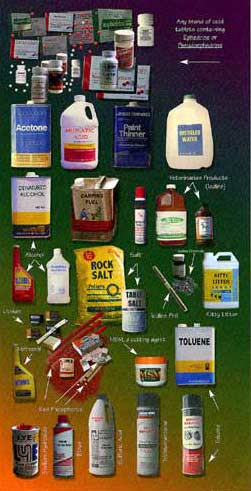Methamphetamine:
In
Move
to
Restore
Funding
Cuts,
Local
Officials
Dub
Meth
Public
Enemy
#1
7/8/05
Police and local officials from across the country used the Tuesday release of a nationwide survey of local officials on the drug problems they faced to call for the restoration of an $804 million drug-fighting program cut from the federal drug budget. According to the survey, officials in 58% of counties across the United States say methamphetamine is their leading problem drug, and they blame it for a variety of woes, from jail overcrowding to increased theft and violent crime to child abuse and neglect.
But while the message came through loud and clear in the headlines, the subtext was not meth but money. Officials from the National Association of Counties, whose report The Meth Epidemic in America, provided the hook for both the news stories and a Tuesday Washington news conference, used the survey's release to plead with federal lawmakers to ignore the Bush administration's plan to eliminate the $800 million Justice Assistance program and instead fund it fully. That program pays for the ubiquitous task forces consisting of law enforcement officers from different jurisdictions who specialize in drug war prosecutions. "This is a national problem that requires national leadership," Angelo Kyle, the president of the association and a member of the Board of Commissioners in Lake County, Illinois, north of Chicago, said at the news conference. The Justice Assistance Program is vital, he told reporters. "With the elimination of that program, that really stifles us from being able to combat this epidemic drug," Mr. Kyle said. Reality is not quite so grim. In fact, it appears the country is facing more of an epidemic of meth-related law enforcement than an epidemic of meth use. According to the 2003 National Household Survey of Drug Use and Health, the latest year available, there is no rapidly spreading epidemic of meth use. "The number of new users of stimulants generally increased during the 1990s, but there has been little change since 2000," the report found. "Incidence of methamphetamine use generally rose between 1992 and 1998. Since then, there have been no statistically significant changes. There were an estimated 323,000 methamphetamine initiates in 2002." That same survey found that methamphetamine use among 12-to-17-year-olds had actually declined from 0.9% in 2002 to 0.7% in 2003. Still, the local officials have opened up a rift between themselves and the White House, accusing drug czar John Walters of placing too much emphasis on preventing marijuana use. "On the national level, the federal government still considers marijuana as the No. 1 drug problem in America, but county law enforcement officials have a different perspective on this ranking," the association said in its survey. "We're not saying that that's misplaced or that they shouldn't be doing this," said Larry Naake, executive director of the association, "but we think that there is now an epidemic that needs to get their attention because it's just as serious, if not more serious, because of the overall consequences of it." A defensive drug czar's office responded that the Bush administration is working on a national methamphetamine strategy, but that it cannot ignore marijuana because of its estimated 15 million users -- compared to an estimated one million meth users. "We do have to keep all drug threats in context, which means you cannot ignore marijuana," said Office of National Drug Control Strategy policy analyst David Murray.
|

